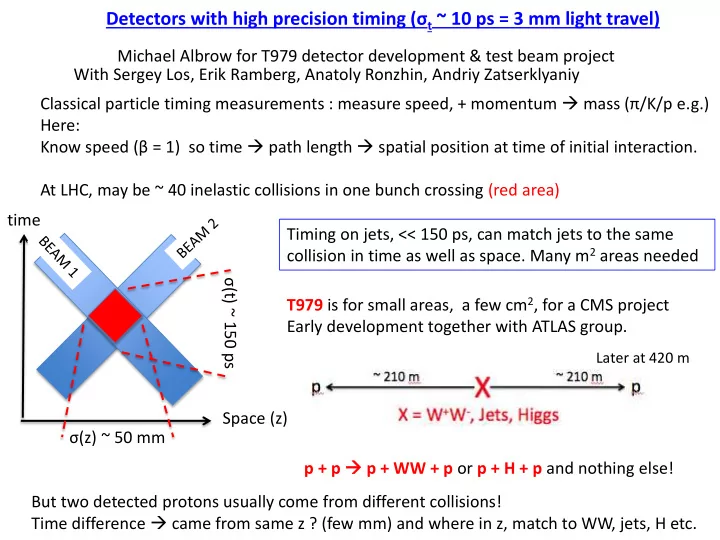

Detectors with high precision timing ( σ t ~ 10 ps = 3 mm light travel) Michael Albrow for T979 detector development & test beam project With Sergey Los, Erik Ramberg, Anatoly Ronzhin, Andriy Zatserklyaniy Classical particle timing measurements : measure speed, + momentum mass (π/K/p e.g.) Here: Know speed (β = 1) so time path length spatial position at time of initial interaction. At LHC, may be ~ 40 inelastic collisions in one bunch crossing (red area) time Timing on jets, << 150 ps, can match jets to the same collision in time as well as space. Many m 2 areas needed σ (t) ~ 150 ps T979 is for small areas, a few cm 2 , for a CMS project Early development together with ATLAS group. Later at 420 m Space (z) σ (z) ~ 50 mm p + p p + WW + p or p + H + p and nothing else! But two detected protons usually come from different collisions! Time difference came from same z ? (few mm) and where in z, match to WW, jets, H etc.
In CMS project, called CT-PPS = CMS TOTEM Precision Proton Spectrometers was approved by Management and Collaboration Boards, MoUs and TDR accepted. Now under consideration by LHCC. PPS : protons have passed through 210m (later 420m) of vacuum pipe with LHC magnets, to be measured in Roman pots a few mm from the beam to 10 μm and 1 μrad (Si tracking) Without the development of good timing detectors (initiated and led by Fermilab) the project could not have been proposed. Requirements: 1) Excellent time resolution ( σ (t) ~ 20 ps 10 ps) 2) Edgeless on beam side ( Δx <~ 200 μm ) 3) Radiation hard close to beam (~ 10 15 p/cm 2 ) 4) Fast readout (25 ns crossings) --- & trigger signal 5) Segmentation (multi-hit capability) Solution developed: Cherenkov light (prompt) in solid: quartz . Other e.g. sapphire under study Segmentation using array of quartz bars. Light detected in array of SiPMs or MicroChannel Plate (MCP-) PMTs Bar geometries take light away from beam (high radiation zone).
Geometry 1: angled bar QUARTIC 48 o Set-up in Mtest, with PMT240 (2 MCPs, 40mm diam) > 20K$ each! Not segmented. Resolution vs # bars: 2 modules 10 ps Need segmented anode. Lifetime limit, now “solved” This geometry pursued by ATLAS with improvements.
L- bar geometry. Only total internal reflections (protons parallel to radiator, n > √2 (quartz) Three 30mm bars In line + PMT240 ref. signal Prototype for beam tests (2 in line- 4 bars) Scope traces, 1 event. 2ns/div, 20mV/div σ (t) = 31ps/bar 2-in-line 22ps Improvements possible
QUARTICs chosen as baseline timing detector for CT-PPS • Cherenkov light in quartz bars – n=1.475, q =47.3 o , at 350 nm. – r= 2.20 g·cm −3 , l I = 44.5 cm. • Quartic module: – 4x5=20 3x3 mm 2 bar elements – 200 μm wire grid separating the bars – active area is 12.6 mm x 15.8 mm Further developments for 2015: L-bars + long life multi-anode MCP-PMTs Finer segmentation. Materials (e.g. sapphire)
Recommend
More recommend